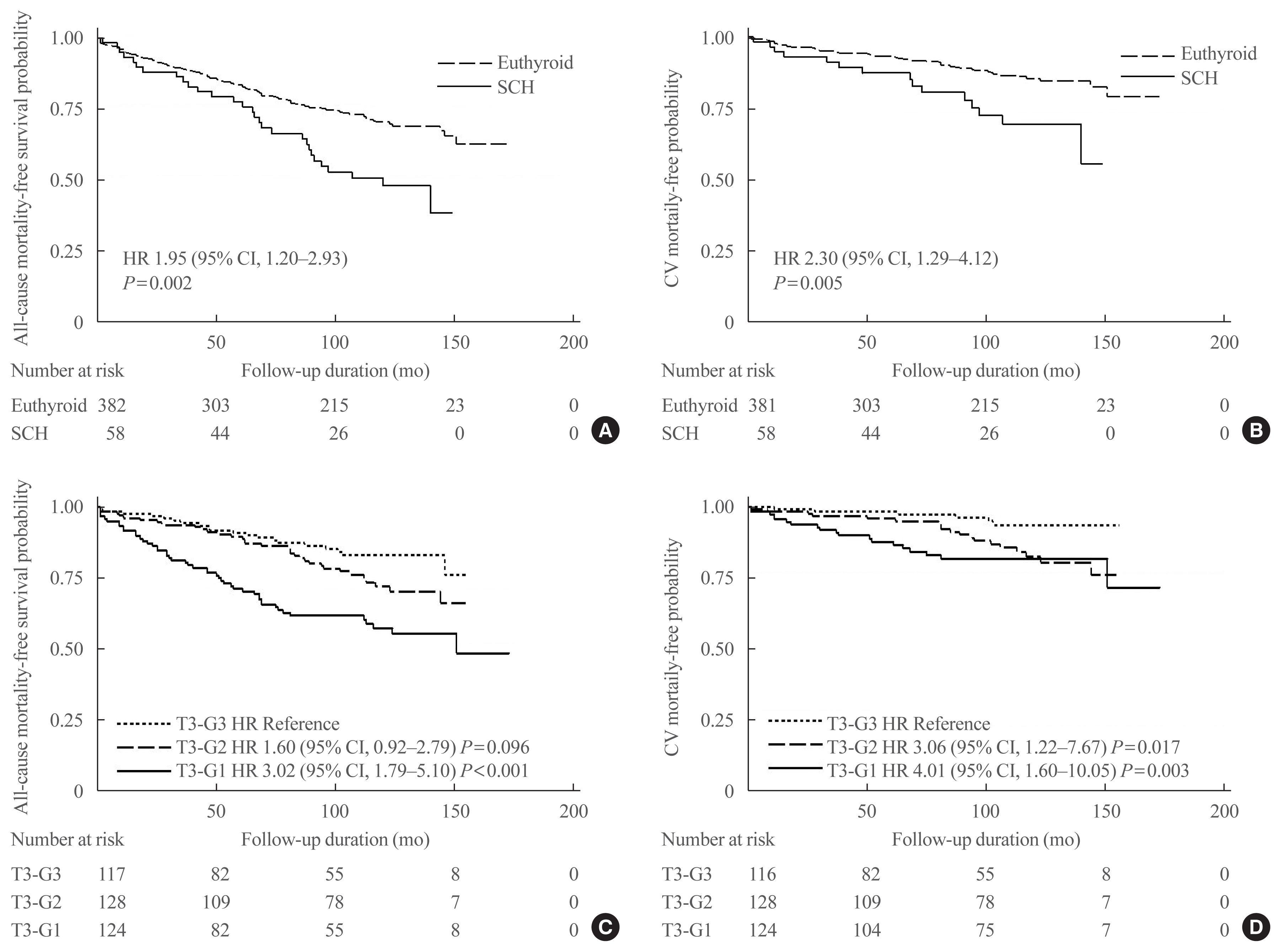Abstract
Background
Methods
Results
ACKNOWLEDGMENTS
REFERENCES
Fig. 1

Table 1
| Variable | Patients with IHD | Patients with VHD | P valuea | ||||||
|---|---|---|---|---|---|---|---|---|---|
|
|
|
||||||||
| Total (n=461) | Euthyroid (n=395) | SCH (n=66) | P value | Total (n=104) | Euthyroid (n=87) | SCH (n=17) | P value | ||
| Age, yr | 65.9±9.9 | 65.8±9.8 | 66.4±10.4 | 0.651 | 60.7±12.4 | 60.7±12.3 | 60.7±12.8 | 0.994 | <0.001 |
|
|
|||||||||
| Male sex | 329 (71.4) | 288 (72.9) | 41 (62.1) | 0.073 | 47 (45.2) | 43 (49.4) | 4 (23.5) | 0.064 | <0.001 |
|
|
|||||||||
| BMI, kg/m2 | 24.7±3.0 | 24.7±3.0 | 24.7±3.0 | 0.996 | 23.9±3.5 | 23.9±3.6 | 24.1±3.2 | 0.824 | <0.050 |
|
|
|||||||||
| Hypertension | 346 (75.1) | 293 (74.2) | 53 (80.3) | 0.219 | 32 (30.8) | 29 (33.3) | 3 (17.6) | 0.258 | <0.001 |
|
|
|||||||||
| Diabetes | 243 (52.7) | 205 (51.9) | 38 (57.6) | 0.350 | 11 (10.6) | 9 (10.3) | 2 (11.8) | 1.000 | <0.001 |
|
|
|||||||||
| Dyslipidemia | 181 (39.3) | 157 (39.8) | 24 (36.4) | 0.592 | 4 (3.8) | 3 (3.4) | 1 (5.9) | 0.516 | <0.001 |
|
|
|||||||||
| Chronic kidney disease | 62 (13.5) | 50 (12.7) | 12 (18.2) | 0.243 | 3 (2.9) | 2 (2.3) | 1 (5.9) | 0.418 | 0.001 |
|
|
|||||||||
| Cerebrovascular disease | 88 (19.1) | 74 (18.8) | 14 (21.2) | 0.615 | 15 (14.4) | 14 (16.1) | 1 (5.9) | 0.456 | 0.325 |
|
|
|||||||||
| Current smoking | 110 (23.9) | 97 (24.6) | 13 (19.7) | 0.438 | 43 (41.3) | 40 (46.0) | 3 (17.6) | 0.034 | <0.001 |
|
|
|||||||||
| TSH, mIU/L | 2.45±1.79 | 1.91±0.90 | 5.7±2.3 | <0.001 | 2.61±1.52 | 2.09±0.91 | 5.32±1.09 | <0.001 | 0.398 |
|
|
|||||||||
| Free T4, ng/dL | 1.15±0.22 | 1.15±0.22 | 1.15±0.23 | 0.896 | 1.22±0.23 | 1.24±0.22 | 1.14±0.29 | 0.132 | 0.005 |
|
|
|||||||||
| Total T3, ng/dL | 87.7±42.4 | 81.7±45.5 | 97.8±38.6 | 0.003 | 83.4±52.2 | 78.8±55.8 | 82.1±44.5 | 0.792 | 0.449 |
|
|
|||||||||
| Hemoglobin, g/dL | 13.0±2.0 | 13.1±2.0 | 12.6±2.2 | 0.062 | 12.8±2.0 | 12.9±1.9 | 12.5±2.4 | 0.457 | 0.491 |
|
|
|||||||||
| Fasting glucose, mg/dL | 65.7±66.8 | 66.2±66.2 | 62.9±70.9 | 0.713 | 35.8±49.7 | 35.9±50.0 | 35.3±49.8 | 0.962 | <0.001 |
|
|
|||||||||
| HbA1c, % | 5.0±2.7 | 5.0±3.4 | 5.5±3.2 | 0.215 | 2.7±3.1 | 2.7±3.1 | 2.6±3.4 | 0.909 | <0.001 |
|
|
|||||||||
| Total cholesterol, mg/dL | 177.3±40.0 | 177.2±39.2 | 178.0±45.1 | 0.880 | 179.5±45.5 | 176.8±41.4 | 192.8±62.5 | 0.187 | 0.626 |
|
|
|||||||||
| LDL-C, mg/dL | 68.3±52.4 | 68.8±51.8 | 65.1±56.0 | 0.594 | 55.1±53.5 | 52.9±51.7 | 66.5±61.2 | 0.338 | 0.021 |
|
|
|||||||||
| HDL-C, mg/dL | 39.3±19.0 | 38.8±9.2 | 42.1±17.7 | 0.194 | 34.5±23.3 | 34.6±22.4 | 33.6±8.1 | 0.868 | 0.049 |
|
|
|||||||||
| Triglyceride, mg/dL | 126.0±91.2 | 124.5±88.8 | 134.9±104.9 | 0.390 | 94.3±80.0 | 97.6±80.5 | 77.4±77.4 | 0.342 | 0.001 |
|
|
|||||||||
| CRP, mg/dL | 1.20±2.69 | 1.18±2.78 | 1.31±2.11 | 0.737 | 0.86±1.53 | 0.88±1.55 | 0.77±1.48 | 0.808 | 0.259 |
|
|
|||||||||
| Creatinine, mg/dL | 1.42±1.31 | 1.39±1.29 | 1.62±1.39 | 0.186 | 1.05±0.30 | 1.04±0.27 | 1.11±0.43 | 0.366 | <0.001 |
IHD, ischemic heart disease; VHD, valvular heart disease; SCH, subclinical hypothyroidism; BMI, body mass index; TSH, thyroid-stimulating hormone; T4, thyroxine; T3, triiodothyronine; HbA1c, hemoglobin A1c; LDL-C, low-density lipoprotein cholesterol; HDL-C, high-density lipoprotein cholesterol; CRP, C-reactive protein.
Table 2
Table 3
Multivariable Cox regression analysis was done. Model 1 adjusted for age and sex. Model 2 adjusted for the factors in model 1 and additionally adjusted for body mass index, smoking status, history of diabetes, and hypertension, dyslipidemia, and chronic kidney disease. Model 3 adjusted for the factors in model 2 and additionally adjusted for left ventricular dysfunction (ejection fraction <40%) and emergent surgery. HR, hazard ratio; CI, confidence interval; MACE, major adverse cardiovascular events.
Table 4
Values are expressed as number (%). P values were analyzed by the log-rank test. Total T3 tertiles in patients with IHD: T3-G1, 0.3 to 83 ng/dL; T3-G2, 85 to 109 ng/dL; T3-G3, 110 to 163 ng/dL. Total T3 tertiles in patients with VHD: T3-G1, 0.3 to 80 ng/dL; T3-G2, 83 to 118 ng/dL; T3-G3, 119 to 167 ng/dL.
Table 5
Multivariable Cox regression analysis was done. The hazard ratios are for T3-G1 and T3-G2 participants with T3-G3 as reference. Model 1 adjusted for age and sex. Model 2 adjusted for the factors in model 1 and additionally adjusted for body mass index, smoking status, history of diabetes and hypertension, dyslipidemia, and chronic kidney disease. Model 3 adjusted for the factors in model 2 and additionally adjusted for left ventricular dysfunction (ejection fraction <40%) and emergent surgery. Total T3 tertiles: T3-G1, 0.3 to 83 ng/dL; T3-G2, 85 to 109 ng/dL; T3-G3, 110 to 163 ng/dL.




 PDF
PDF Citation
Citation Print
Print



 XML Download
XML Download